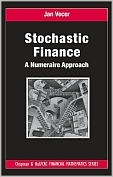| |||||
• polskie
• Zamów informacje o nowościach z wybranego tematu • kontakt |
STOCHASTIC FINANCE: A NUMERAIRE APPROACHVECER J.wydawnictwo: CRC PRESS, 2011, wydanie Icena netto: net price + 5% vat. Unlike much of the existing literature, Stochastic Finance: A Numeraire Approach treats price as a number of units of one asset needed for an acquisition of a unit of another asset instead of expressing prices in dollar terms exclusively. This numeraire approach leads to simpler pricing options for complex products, such as barrier, lookback, quanto, and Asian options. Most of the ideas presented rely on intuition and basic principles, rather than technical computations. The first chapter of the book introduces basic concepts of finance, including price, no arbitrage, portfolio, financial contracts, the First Fundamental Theorem of Asset Pricing, and the change of numeraire formula. Subsequent chapters apply these general principles to three kinds of models: binomial, diffusion, and jump models. The author uses the binomial model to illustrate the relativity of the reference asset. In continuous time, he covers both diffusion and jump models in the evolution of price processes. The book also describes term structure models and numerous options, including European, barrier, lookback, quanto, American, and Asian. Classroom-tested at Columbia University to graduate students, Wall Street professionals, and aspiring quants, this text provides a deep understanding of derivative contracts. It will help a variety of readers from the dynamic world of finance, from practitioners who want to expand their knowledge of stochastic finance, to students who want to succeed as professionals in the field, to academics who want to explore relatively advanced techniques of the numeraire change. Jan Vecer is a professor of finance and has taught courses on stochastic finance at Columbia University, the University of Michigan, Kyoto University, and the Frankfurt School of Finance and Management. His research interests encompass areas within financial statistics, financial engineering, and applied probability, including option pricing, optimal trading strategies, stochastic optimal control, and stochastic processes. He earned a Ph.D. in mathematical finance from Carnegie Mellon University.Table of Contents
342 pages, Hardcover Księgarnia nie działa. Nie odpowiadamy na pytania i nie realizujemy zamówien. Do odwolania !. |


